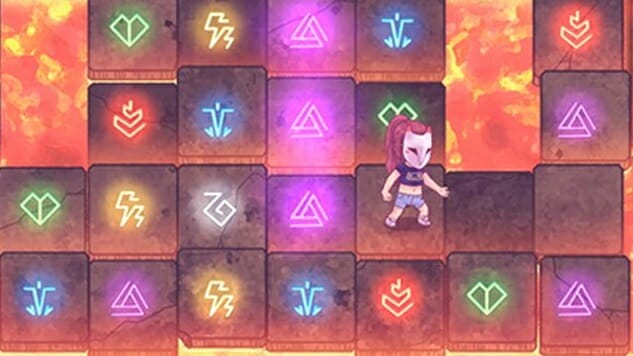The World Next Door Is an Inspired Anime Riff on Classic Puzzle Games
Games Reviews The World Next Door
The World Next Door is a game that, like Battle Chef Brigade of last year, puts an impressive fresh spin on the match-3 format. For as addictive as match-3 games can be, you really don’t need to dress it up much. Just look at the popularity of Bejeweled or Candy Crush Saga. Beyond some shiny visuals, there’s not a lot there, but with such a trance-inducing style of gameplay, it doesn’t matter. People will play it anyway. In that sense, The World Next Door doesn’t need to be as cool as it is, with it’s impossibly hip Monster Prom meets Hotline Miami character designs and evil-cute aesthetic. And yet, here we are.
In The World Next Door, the human Jun wins a lottery to travel to the other side of a cross-world portal, taking her to the magic realm of Emrys. Things quickly take a turn, however, as a late night in a forbidden shrine prevents her from reaching the return portal in time, trapping her in Emrys forever—or at least until her death in a few short days. With very little time to figure out how to send Jun back home, she and her friends band together as she takes on the puzzles of the shrines, imbuing a magic sword with the power necessary to re-open the door leading home. Each “battle” consists of a small open floor face embedded with elemental based symbols that, when matched in groups of three, cast spells on Jun’s behalf, whittling down the hitpoints of their opponent, known as a Grievance. Larger groups of symbols cast more powerful spells, and multiple spells grouped adjacently cast stronger effects. Special configurations of certain symbols can also summon the assist spells of group members for extra damage, and Grievances and environmental damage can flip, remove or damage symbols or their space on the floor, rendering them inaccessible. The challenge and fun is in dodging the spells of Grievances while navigating the hazards of the level, while figuring out the best and most damaging means to cast spells of your own. The pacing really keeps you on your toes.
Although the puzzle sections are a lot of fun, it doesn’t feel like there are enough of them. The game is fairly short and the dungeons themselves have only a handful or so puzzles and the structure of each dungeon itself is very basic. The narrative itself also covers a lot of well worn territory, and while the character designs are very cool, the lore building itself feels a bit lacking. There isn’t much known about Emrys and its citizens, and the tale of an otherworldly outsider just trying to get home is too familiar to be compelling. Between that and the skimpy dungeons, it feels like there should have been a lot more to the game.
The World Next Door would benefit from having a lot more puzzles, which is a compliment: it means I like playing it a lot. Tetris, Bejeweled, Dr. Mario—all the greats let you play for multiple mindless rounds in a row and I’m aching to do that with The World Next Door now that I’ve beat it. I hope they’ll consider releasing an endless mode because I could see myself sinking in many more hours if given half a chance.
My trip through the The World Next Door might have been short, but it was still worth the journey. I look forward to seeing how Rose City Games expands on it in the future.
The World Next Door was developed by Rose City Games and published by Viz Media. Our review is based on the PC version. It is also available for the Switch.
Holly Green is the assistant editor of Paste Games and a reporter and semiprofessional photographer. She is also the author of Fry Scores: An Unofficial Guide To Video Game Grub. You can find her work at Gamasutra, Polygon, Unwinnable, and other videogame news publications.